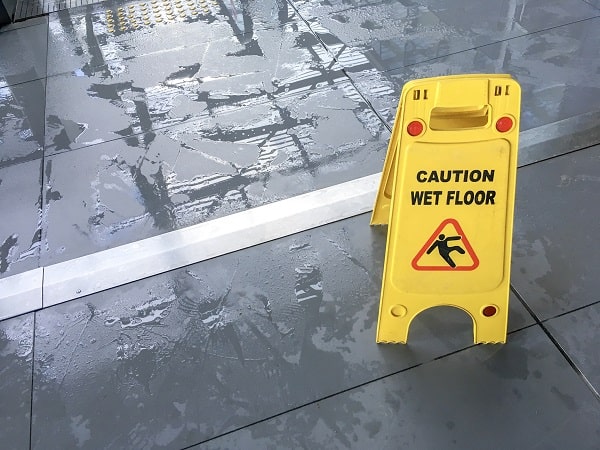May is
Building Safety Month, a month dedicated to spreading awareness about the importance of creating safe, sustainable buildings through the adoption of modern, regularly-updated building codes. As new building codes that enhance safety are created and/or modified frequently, it’s important businesses stay up-to-date with meaningful improvements, even if in many cases existing buildings are “grandfathered” into the standards they were originally built to. Being able to recognize workplace hazards can help minimize not only employee injuries, but also those experienced by visitors or the general public.
The Dangers of Slips, Trips and Falls in the Workplace

Millions of people receive treatment for fall-related injuries in emergency rooms every year. According to the
National Safety Council (NSC), falls are the third leading cause of unintentional injury-related deaths. When it comes to suffering a fatal injury from a fall, a worker doesn’t even have to fall from a high level. In fact, 12 percent of fatal falls occurred from a height of less than six feet.
While those working in the construction industry are most at risk for a fatal fall, falls can happen in any setting – even an office environment. Falls that occur at the same level (not from heights) are often due to hazardous conditions like uneven or slippery walkway surfaces, contaminants on walkways, inadequate lighting or maintenance, poor housekeeping or poorly-designed walkway surfaces.

For property owners, slips, trips and falls often result in litigation. If an individual suffers an injury by falling at a commercial property, he or she may claim the owner was negligent in providing a safe walkway. Negligence may be demonstrated by the existence of an allegedly dangerous condition that the property owner had knowledge of but failed to properly manage. When an employee is injured due to a fall, this can result in a costly
workers’ compensation claim. In fact, the
CDC reports that the medical and workers’ comp expenses associated with occupational fall incidents have been estimated at $70 billion annually in the United States.
Preventing Slips, Trips and Falls by Improving Walkway Safety
Slippery, cluttered or unstable walkways or working surfaces commonly result in falls in the workplace. Here are a few ways to increase walkway safety to help reduce the risk of employee injuries from a fall:
 Use mats and runners in wet conditions
Use mats and runners in wet conditions Wet weather conditions or spills are one of the most common slip, trip and fall hazards in the workplace. To address this risk, place absorbent or abrasive mats and runners in areas that often get wet or slippery, such as entrances, around sinks or ice machines. Additionally, when these mats get dirty or saturated, make sure to exchange them for clean ones. In unusually wet, snowy or icy conditions, addition of extra “walk-off” mats at building entrances can be a good idea to keep floors clean and free of slip hazards.
Provide adequate lighting Good visibility is essential in preventing slips, trips and falls. Regularly review the grounds to determine if the lighting is adequate for all times of the day and seasons of the year, keeping in mind both the earliest and latest times employees or visitors are on the premises. If deficient areas are found, add lighting to interior and exterior walkways as needed, and make replacing any burnt out bulbs a priority.
Watch the transitions Research shows that when individuals walk from a smooth surface to a rough surface, the likelihood of a slip, trip or fall incident increases. Also, footwear can get caught when someone walks from a tile floor onto carpeting, and it can be common for a walkway to have flooring materials with vastly different slip resistances installed. Make sure high-traffic walkways utilize the same type of flooring as much as possible. In some cases, special focused lighting may be necessary to call attention to transitions that cannot be otherwise controlled.
 Post warning signs for slippery conditions
Post warning signs for slippery conditions It is always preferable to repair or otherwise mitigate known slip or trip hazards when possible, but as this is not always possible, posting warning signs becomes necessary. When individuals are alerted to the possibility of a fall, they will alter their gait accordingly. For example, if a sign is posted that the walkway is slippery when wet and a puddle is observed in the path, people will make an effort to avoid the potentially hazardous area, thus reducing the risk for a slip or fall.
Establish a cleaning and maintenance program When it comes to preventing slips and falls, the importance of proper cleaning and maintenance of walkways cannot be stressed enough. Dirt on floors can lead to eroding of non-slip floor coatings and compromise the roughness of the walkway, which can decrease the slip-resistance of the surface. Establish a regular cleaning program and adhere to the guidelines provided by the flooring manufacturer and the cleaning product supplier. Remove clutter from walkways to reduce the risk of people tripping over debris in their path. Additionally, when floors begin to show wear and tear along walkways, make sure to repair or replace them as needed.
Loss Control Services from AmTrust Financial
Proper risk management can help your organization maintain building code compliance and help reduce injuries, accidents and penalty fees. AmTrust’s
Loss Control Department is dedicated to providing meaningful recommendations and
resources to help create the most effective loss prevention program for your company. For more information, please
contact us today.
This material is for informational purposes only and is not legal or business advice. Neither AmTrust Financial Services, Inc. nor any of its subsidiaries or affiliates represents or warrants that the information contained herein is appropriate or suitable for any specific business or legal purpose. Readers seeking resolution of specific questions should consult their business and/or legal advisors. Coverages may vary by location. Contact your local RSM for more information.